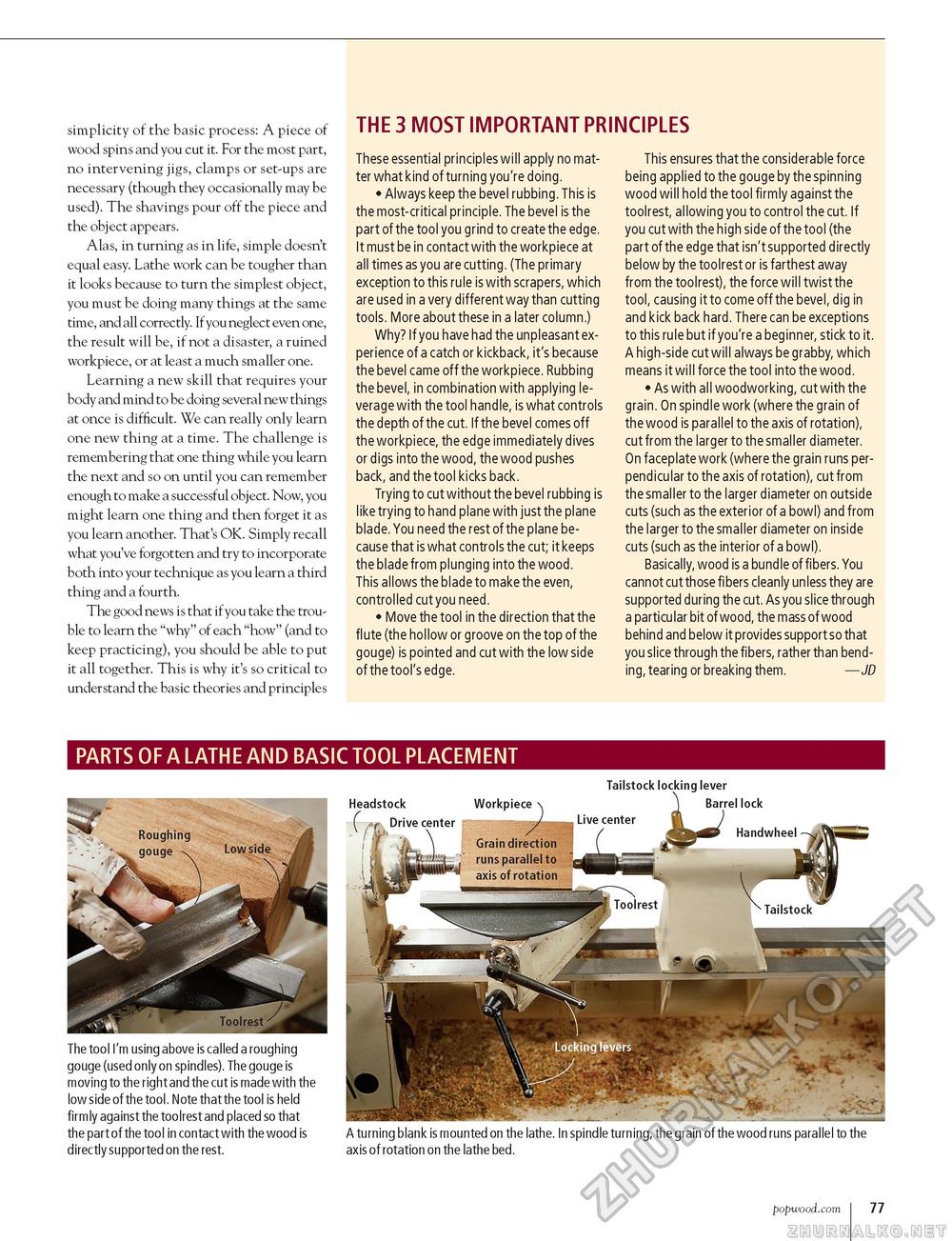Popular Woodworking 2004-08 № 142, страница 79
simplicity of the basic process: A piece of wood spins and you cut it. For the most part, no intervening jigs, clamps or set-ups are necessary (though they occasionally may be used). The shavings pour off the piece and the object appears. Alas, in turning as in life, simple doesn't equal easy. Lathe work can be tougher than it looks because to turn the simplest object, you must be doing many things at the same time, and all correctly. If you neglect even one, the result will be, if not a disaster, a ruined workpiece, or at least a much smaller one. Learning a new skill that requires your body and mind to be doing several new things at once is difficult. We can really only learn one new thing at a time. The challenge is remembering that one thing while you learn the next and so on until you can remember enough to make a successful object. Now, you might learn one thing and then forget it as you learn another. That's OK. Simply recall what you've forgotten and try to incorporate both into your technique as you learn a third thing and a fourth. The good news is that if you take the trouble to learn the "why" of each "how" (and to keep practicing), you should be able to put it all together. This is why it's so critical to understand the basic theories and principles THE 3 MOST IMPORTANT PRINCIPLES These essential principles will apply no matter what kind of turning you're doing. • Always keep the bevel rubbing. This is the most-critical principle. The bevel is the part of the tool you grind to create the edge. It must be in contact with the workpiece at all times as you are cutting. (The primary exception to this rule is with scrapers, which are used in a very different way than cutting tools. More about these in a later column.) Why? If you have had the unpleasant experience of a catch or kickback, it's because the bevel came off the workpiece. Rubbing the bevel, in combination with applying leverage with the tool handle, is what controls the depth of the cut. If the bevel comes off the workpiece, the edge immediately dives or digs into the wood, the wood pushes back, and the tool kicks back. Trying to cut without the bevel rubbing is like trying to hand plane with just the plane blade. You need the rest of the plane because that is what controls the cut; it keeps the blade from plunging into the wood. This allows the blade to make the even, controlled cut you need. • Move the tool in the direction that the flute (the hollow or groove on the top of the gouge) is pointed and cut with the low side of the tool's edge. This ensures that the considerable force being applied to the gouge by the spinning wood will hold the tool firmly against the toolrest, allowing you to control the cut. If you cut with the high side of the tool (the part of the edge that isn't supported directly below by the toolrest or is farthest away from the toolrest), the force will twist the tool, causing it to come off the bevel, dig in and kick back hard. There can be exceptions to this rule but if you're a beginner, stick to it. A high-side cut will always be grabby, which means it will force the tool into the wood. • As with all woodworking, cut with the grain. On spindle work (where the grain of the wood is parallel to the axis of rotation), cut from the larger to the smaller diameter. On faceplate work (where the grain runs perpendicular to the axis of rotation), cut from the smaller to the larger diameter on outside cuts (such as the exterior of a bowl) and from the larger to the smaller diameter on inside cuts (such as the interior of a bowl). Basically, wood is a bundle of fibers. You cannot cut those fibers cleanly unless they are supported during the cut. As you slice through a particular bit of wood, the mass of wood behind and below it provides support so that you slice through the fibers, rather than bending, tearing or breaking them. — JD PARTS OF A LATHE AND BASIC TOOL PLACEMENT Roughing gouge jj The tool I'm using above is called a roughing gouge (used only on spindles). The gouge is moving to the right and the cut is made with the low side of the tool. Note that the tool is held firmly against the toolrest and placed so that the part of the tool in contact with the wood is directly supported on the rest. Headstock Workpiece C Drive center , \ Grain direction Tailstock locking lever Barrel lock A turning blank is mounted on the lathe. In spindle turning, the grain of the wood runs parallel to the axis of rotation on the lathe bed. popwood.com 77 |








